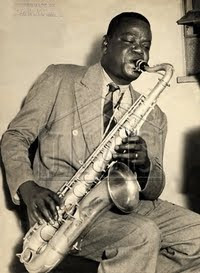Playing Choro
.jpg) In the 1950s Jacob do Bandolim was deeply engaged in a pedagogical project to save choro music from oblivion. At that time the musical taste of the general public in Brazil no longer favored choro due to the influence of forreign (- mainly American) music that was promoted by record companies, radio and TV. However,as a highly respected and well known musician, Jacob do Bandolim had an opportunity to reach the public through several radio and TV programs that promoted choro and related Brazilian music. Jacob produced choro contests on radio and TV, fronted live shows featuring amateur musicians playing choro and he was tireless in encouraging the public to devote their interest into playing choro. In one of his radio programs he called for attention by saying:
In the 1950s Jacob do Bandolim was deeply engaged in a pedagogical project to save choro music from oblivion. At that time the musical taste of the general public in Brazil no longer favored choro due to the influence of forreign (- mainly American) music that was promoted by record companies, radio and TV. However,as a highly respected and well known musician, Jacob do Bandolim had an opportunity to reach the public through several radio and TV programs that promoted choro and related Brazilian music. Jacob produced choro contests on radio and TV, fronted live shows featuring amateur musicians playing choro and he was tireless in encouraging the public to devote their interest into playing choro. In one of his radio programs he called for attention by saying:"... Why don't you get together with your old friends for a choro session next Sunday instead of sleeping in? Put some new strings on your guitar, start warming up tonight and play in front of the group tomorrow. ... We bet that every one of you has already had this idea. ... All that was lacking was a little motivation. ... So here it is ... Get going, chorões, whether you choose C major or A minor ... Picks, reeds and fingers ready to serve good Brazilian music." (quoted from Livingston-Isenhour, T. & Caracas Garcia, T.G.: Choro, A Social History of a Brazilian Popular Music (2005), p.120)
The traditional way of playing and learning how to play choro is the roda, where choro musicians of all levels get together in a unique social event to play and enjoy the company of each other. The idea of the roda is a performance involving all, newcommers as well as old cats join in by listening and learning by doing, no one is excluded in advance. The spirit of the roda is a friendly cutting contest where everyone gets his or her chance to show off and develop playing skills. The art of improvisation is a crucial point to a successful roda, like the jamsession in jazz, and everybody gets a chance to improvise by choosing well known choro tunes - or 'standards' - to inspire and challenge the improvisations skills of the participating musicians. Written music, if any at all, is only a guide line for stating the musical theme being played, not a restrictive 'must' to be followed.
The roda has been carried on as a tradition in choro clubs in Brazil and other places, but if you want to play choro and no club is to be found in your area, what do you do, if you want to learn playing choro? You may start listening to a lot of choro recordings to get aquainted with the usual choro repertoire and the sound of a choro ensemble consentrating on the various instruments involved in the performance. Then pick up your own instrument and try to reproduce the tunes and sound you heard, not as played by a sudden group, but as you yourself would like it to be performed. This is an never ending process that will refine your ear and playing skills, however, this is also the hard, lonesome way as long as you are not playing together with others. By chance you may get together with other musicians interested in playing choro, then the roda once again is the best way to further develop your chops, I think. However, there is also another possibility to learn and play choro in an ensemble setting.
In the 1950s there was developed a pedagogical tool kit to help aspiring musicians learning to play in ensembles. The tool was distributed by an American company that named their pedagogical package Music Minus One. The idea of Music Minus One was to offer the learning musician an opportunity to play in an ensemble by providing the buyer of the package musical scores and recordings of the music both with and without the chosen instrument. For instance, if you played guitar, you could get a package with written music and the recording of a backing ensemble playing the music, first with the guitar 'as it should be played' and then without the guitar, but leaving you the possibility to play along developing your own rendition in an ensemble setting. Now this idea of pedagogical education of aspiring musicians has been relived by a new American company devoting their production to choro music. If you want to know more about their poducts and pedagogical philosophy, I highly recommend a visit at their website. Click on headline to learn more.
Jo



0 Comments:
Post a Comment
<< Home